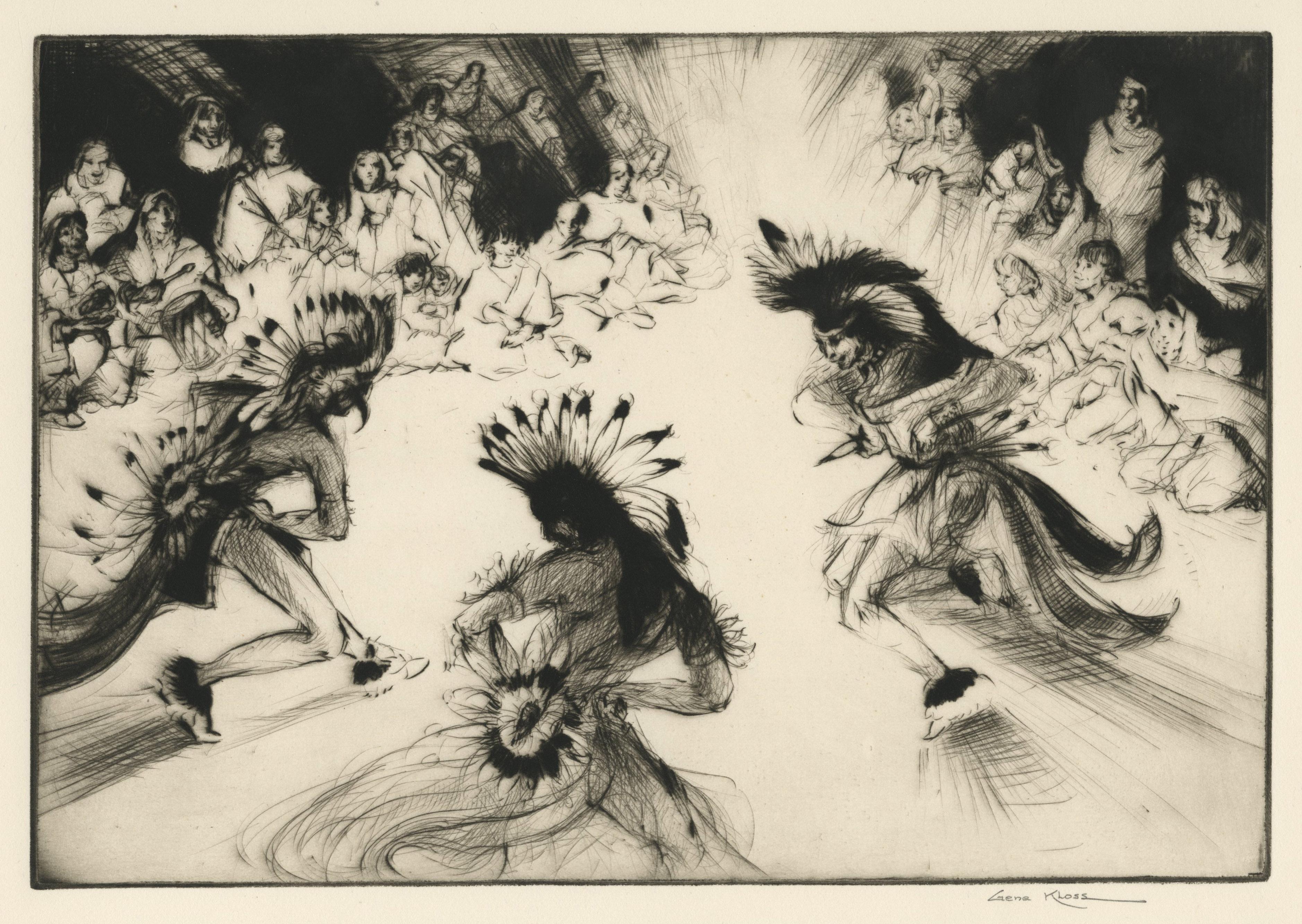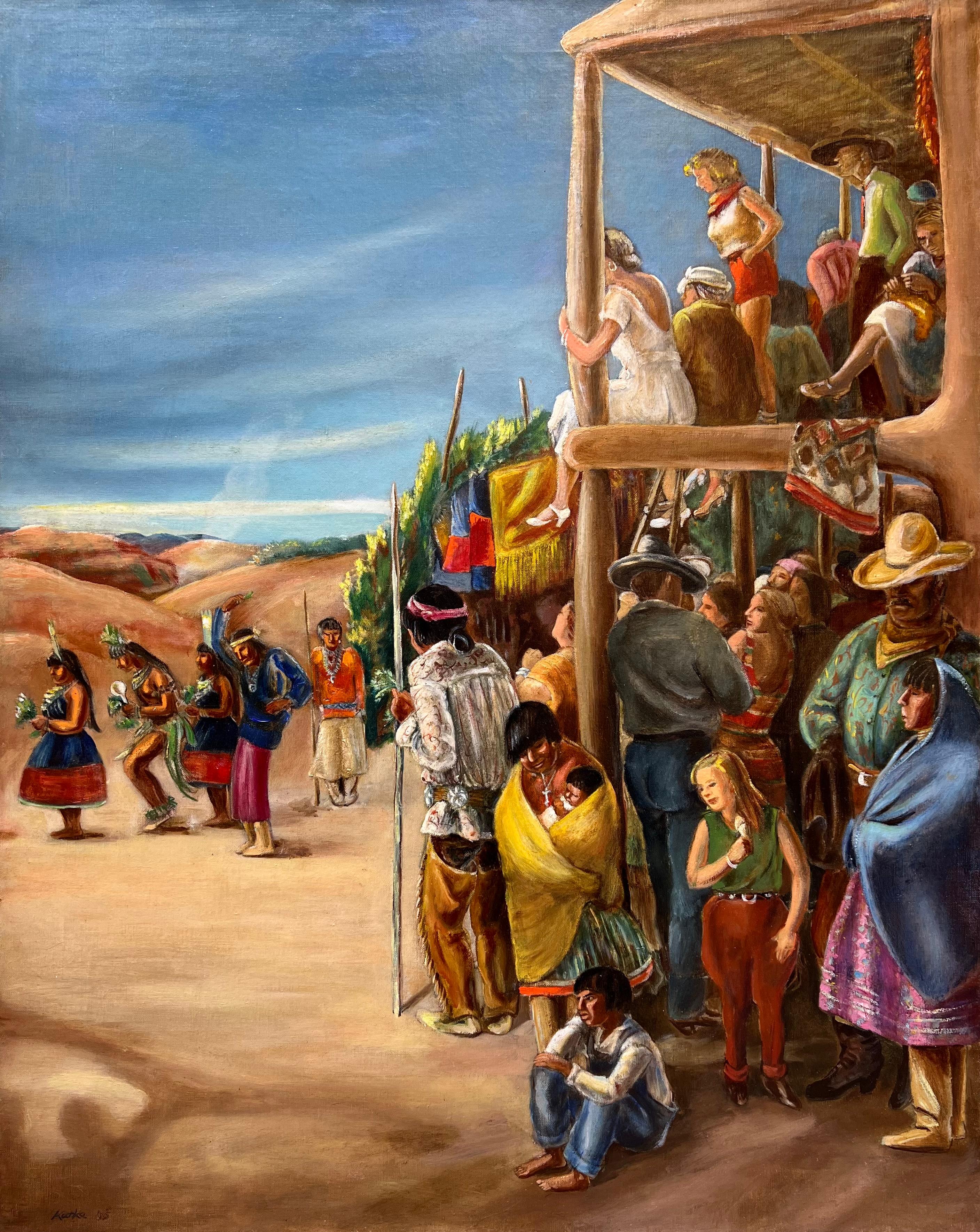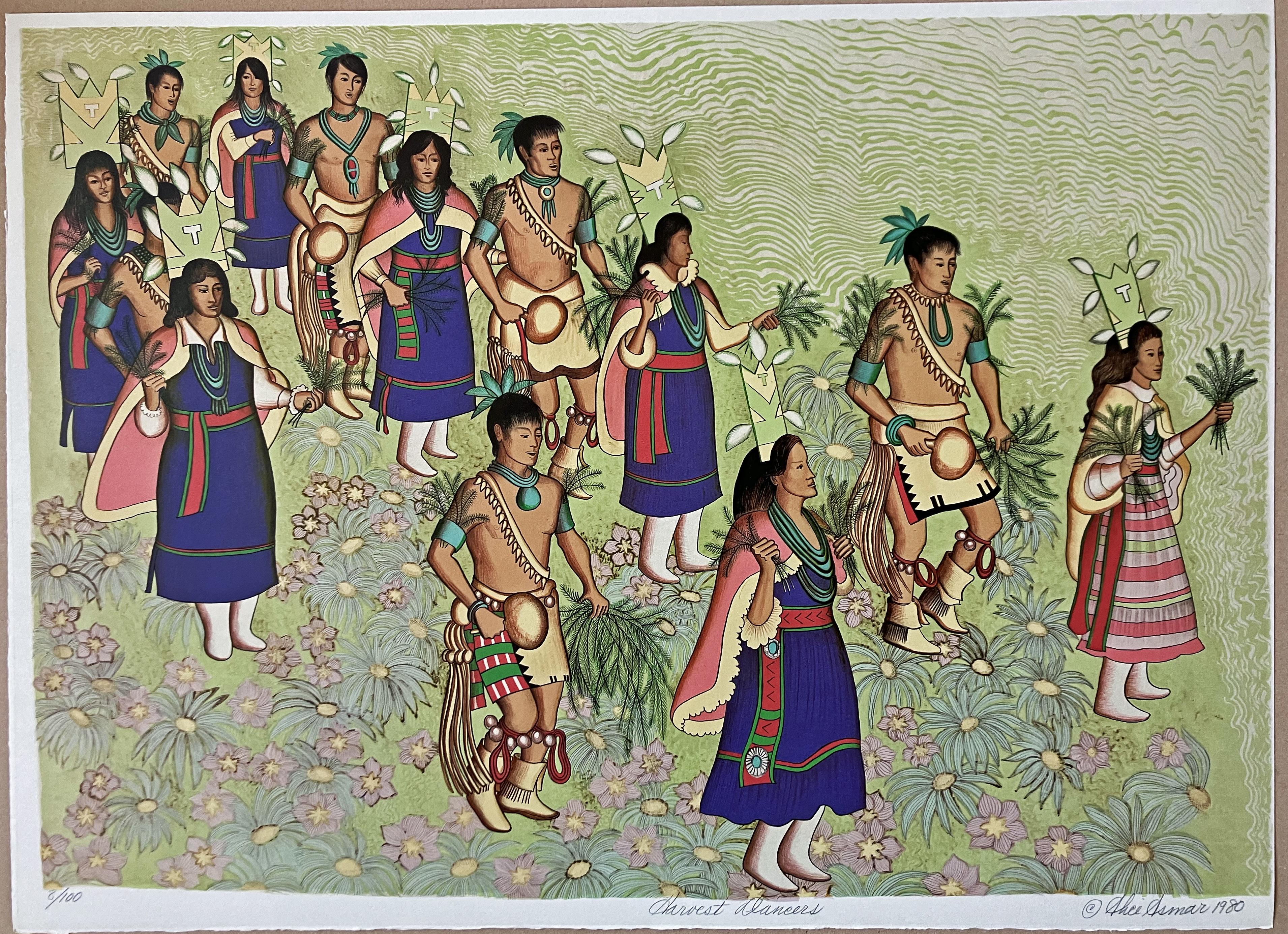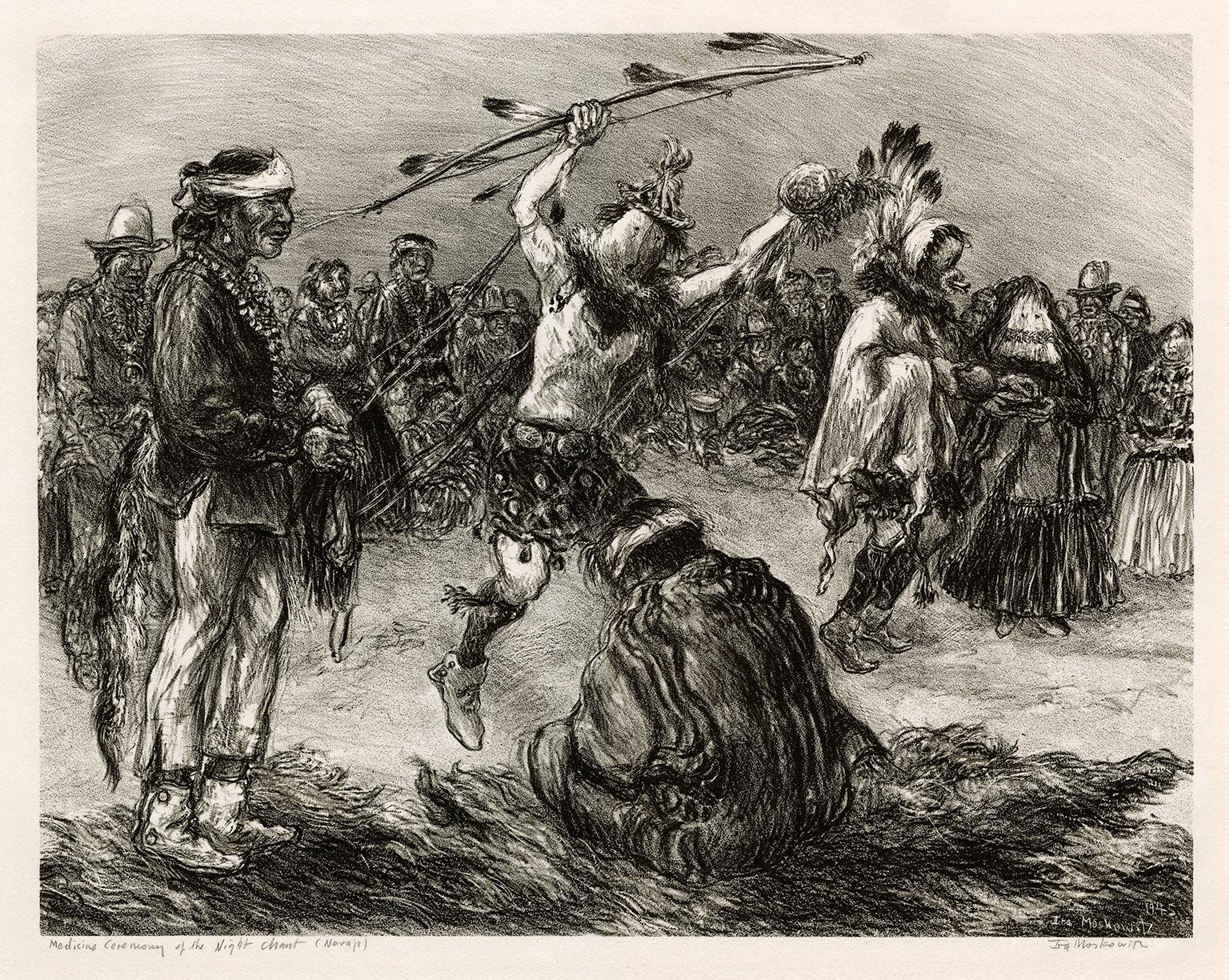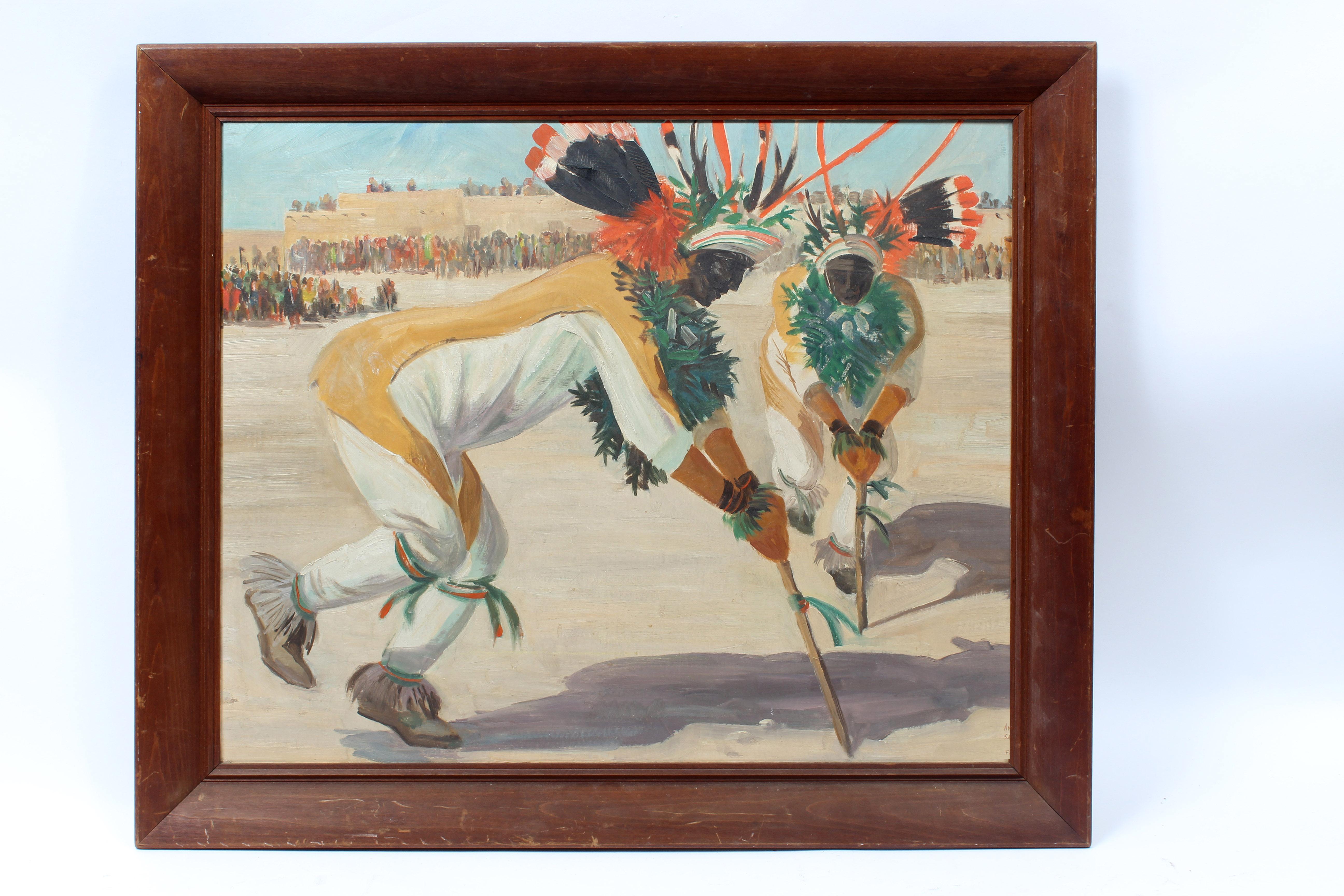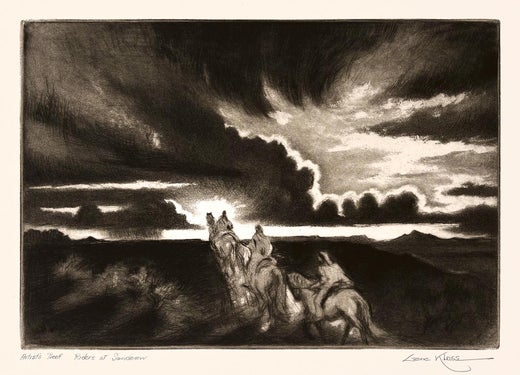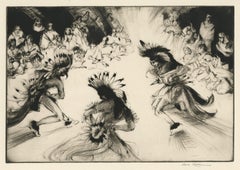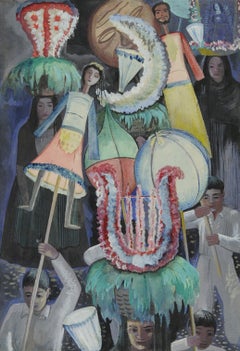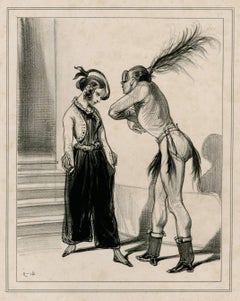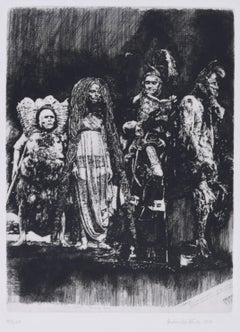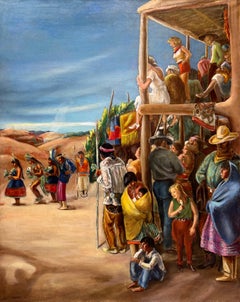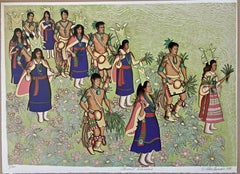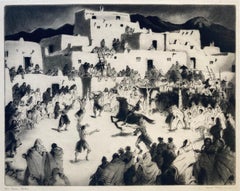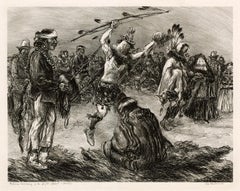Items Similar to Keresan Dancers
Want more images or videos?
Request additional images or videos from the seller
1 of 11
Gene KlossKeresan Dancers1962
1962
$2,250
£1,704.80
€1,956.12
CA$3,166.11
A$3,480.43
CHF 1,829.15
MX$42,265.09
NOK 22,818.24
SEK 21,618.68
DKK 14,599.05
About the Item
Keresan Dancers
Etching & drypoint, 1962
Signed lower right (see photo)
Inscribed lower left: "Artist's Proof Keresan Dancers"
Depicts Keresan speaking peoples at Sam Felipe Pueblo
Contemporary Puebloans are customarily described as belonging to either the eastern or the western division. The eastern Pueblo villages are in New Mexico along the Rio Grande and comprise groups who speak Tanoan and Keresan languages. Tanoan languages such as Tewa are distantly related to Uto-Aztecan, but Keresan has no known affinities. The western Pueblo villages include the Hopi villages of northern Arizona and the Zuni, Acoma, and Laguna villages, all in western New Mexico.
Born Alice Glasier in Oakland, CA, Kloss grew up amid the worldly bustle of the San Francisco Bay Area. She attended the University of California at Berkeley, graduating with honors in art in 1924. She discovered her talents in intaglio printmaking during a senior-year course in figurative drawing. The professor, Perham Nahl, held up a print from Kloss’ first plate, still damp from the printing process, and announced that she was destined to become a printmaker.
In 1925, Gene married Phillips Kloss, a poet and composer who became her creative partner for life. The match was uncanny, for in her own way Gene, too, was a poet and a composer. Like poetry, her artworks capture a moment in time; like music, her compositions sing with aesthetic harmony. Although she was largely self-taught, Kloss was a printmaking virtuoso.
On their honeymoon the Klosses traveled east from California, camping along the way. They spent two week is Taos Canyon – with a portable printing press cemented to a rock near their campsite – where Gene learned to appreciate the wealth of artistic subject matter in New Mexico. The landscape, the cultures, and the immense sky left an indelible impression on the couple, who returned every summer until they made Taos their permanent home 20 years later.
Throughout her life, Kloss etched more than 625 copper plates, producing editions ranging from five to 250 prints. She pulled every print in every edition herself, manually cranking the wheel of her geared Sturges press until she finally purchased a motorized one when she was in her 70s. Believing that subject matter dictated technique, she employed etching, drypoint, aquatint, mezzotint, roulette, softground, and a variety of experimental approaches, often combining several techniques on the same plate. She also produced both oil and watercolor paintings.
Kloss’ artworks are filled with drama. Her prints employ striking contrasts of darkness and light, and her subjects are often illuminated by mysterious light sources. Though she was a devout realist, there is also a devout abstraction on Kloss’ work that adds an almost mythical quality.
For six decades Kloss documented the cultures of the region-from images of daily life to those of rarely seen ceremonies. She and her husband shared a profound respect for the land and people, which made them welcome among the Native American and Hispanic communities. Kloss never owned a camera but relied instead on observation and recollection. Her works provide an inside look at the cultures she depicted yet at the same time communicate the awe and freshness of an outsider’s perspective.
Although Kloss is best known for her images of Native American and Penitente scenes, she found artistic inspiration wherever she was. During the early years of their marriage, when she and Phil returned to the Bay Area each winter to care for their aging families, she created images of the California coast. And when the Klosses moved to southwestern Colorado in 1965, she etched the mining towns and mountainous landscapes around her.
In 1970 the Klosses returned to Taos and built a house north of town. Though her artwork continued to grow in popularity, she remained faithful to Taos’ Gallery A, where she insisted that owner Mary Sanchez keep the prices of her work reasonable regardless of its market value. Kloss continued to etch until 1985, when declining health made printmaking too difficult.
From her first exhibition at San Francisco’s exclusive Gump’s in 1937 to her 1972 election to full membership in the National Academy of Design, Kloss experienced a selective fame. She received numerous awards, and though she is not as well known as members of the Taos Society of Artists, her works are in collections throughout the world including those of the Metropolitan Museum of Art, the National Gallery, the Library of Congress, and the Museum of Tokyo.
Kloss was 93 years old when she died. Alive for most of the 20th century, she witnessed vast changes in our society and landscape. Yet to look at her artwork, one would never know that the world changed. There is remarkable continuity in style and subject matter through the years that gives her work a timeless quality. This is enhanced by Kloss’ ability to capture the spirit of people and places. Her etchings turn brief moments into lasting impressions.
Courtesy: Jennifer Cook, curator of visual arts at the Sangre de Cristo Arts Center.
- Creator:Gene Kloss (1903-1996, American)
- Creation Year:1962
- Dimensions:Height: 13.88 in (35.26 cm)Width: 10.88 in (27.64 cm)
- Medium:
- Movement & Style:
- Period:
- Condition:
- Gallery Location:Fairlawn, OH
- Reference Number:Seller: FA123901stDibs: LU14015288472
Gene Kloss
Gene (Alice Geneva) Kloss is considered one of America’s master printmakers. She was born in Oakland, California and established herself as an artist on the West coast. Kloss was introduced to etching by Perham Nahl while at UC Berkley. She graduated in 1924, and in 1925 married poet Phillips Kloss. In her late twenties, Kloss moved to Taos, New Mexico and began her life’s work of the New Mexican landscape and peoples. It was at this time that she received national acclaim. Her artwork exudes an unmistakable content and style. Enchanted by the architecture, mountainous landscapes and rituals of the inhabitants, Kloss captured the beauty of the Southwest and surrounding areas. Her style was bold yet deftly simple, masterfully expressing the elusive Southwestern light. In 1938, she exhibited in Paris with Ernest Blumenschein, Georgia O’Keeffe, and John Sloan. She was also a member of the National Academy of Design, New York.
About the Seller
5.0
Recognized Seller
These prestigious sellers are industry leaders and represent the highest echelon for item quality and design.
Platinum Seller
Premium sellers with a 4.7+ rating and 24-hour response times
Established in 1978
1stDibs seller since 2013
813 sales on 1stDibs
Typical response time: <1 hour
Associations
International Fine Print Dealers Association
- ShippingRetrieving quote...Shipping from: Akron, OH
- Return Policy
Authenticity Guarantee
In the unlikely event there’s an issue with an item’s authenticity, contact us within 1 year for a full refund. DetailsMoney-Back Guarantee
If your item is not as described, is damaged in transit, or does not arrive, contact us within 7 days for a full refund. Details24-Hour Cancellation
You have a 24-hour grace period in which to reconsider your purchase, with no questions asked.Vetted Professional Sellers
Our world-class sellers must adhere to strict standards for service and quality, maintaining the integrity of our listings.Price-Match Guarantee
If you find that a seller listed the same item for a lower price elsewhere, we’ll match it.Trusted Global Delivery
Our best-in-class carrier network provides specialized shipping options worldwide, including custom delivery.More From This Seller
View AllIndian Friendship Dance
By Gene Kloss
Located in Fairlawn, OH
Indian Friendship Dance
Drypoint, 1953
Signed in pencil lower right, (see photo)
Edition 200
Published by The Society of American Graphic Artists, New York
An impression is in the collection of SAAM, Washington and RISD Museum,
Condition: Excellent
Very rich impression with burr and selective whiping of the ink for atmospheric nocturnal effect.
Image/Plate size: 8 3/16 x 11 15/16 inches
Sheet size: 11 1/8 x 17 inches
Reference: Kloss 450
"'Indian Friendship Dance' is an eloquent statement of something which Gene Kloss has both observed and participated in. It is an Indian dance that is thought of as entertainment, rather than ceremony, but it is essentially an idea expressed in action, and an idea that has universal meaning. The young men who dance wear costumes of exquisite workmanship, intricately wrought with beads and feathers and subtle combinations of colors. The dancers are trained from childhood but develop their own steps and exhibit distinctive strength and grace. Singers and a tom-tom accompany the dance and since it usually takes place at night, a campfire is the source of light. The conclusion occurs when all the onlookers, old and young and from many places, join hands with the dancers in a slow revolving movement, while those who can, sing the difficult but meaningful Indian song that flows with the rhythmical dance step and speaks of fellowship, brotherhood, friendship." - An excerpt from a descriptive statement, written by Lynd Ward, and distributed with the drypoint at the time of publication." Courtesy Old Print Shop
Born Alice Glasier in Oakland, CA, Kloss grew up amid the worldly bustle of the San Francisco Bay Area. She attended the University of California at Berkeley, graduating with honors in art in 1924. She discovered her talents in intaglio printmaking during a senior-year course in figurative drawing. The professor, Perham Nahl, held up a print from Kloss’ first plate, still damp from the printing process, and announced that she was destined to become a printmaker.
In 1925, Gene married Phillips Kloss, a poet and composer who became her creative partner for life. The match was uncanny, for in her own way Gene, too, was a poet and a composer. Like poetry, her artworks capture a moment in time; like music, her compositions sing with aesthetic harmony. Although she was largely self-taught, Kloss was a printmaking virtuoso.
On their honeymoon the Klosses traveled east from California, camping along the way. They spent two week is Taos Canyon – with a portable printing press cemented to a rock near their campsite – where Gene learned to appreciate the wealth of artistic subject matter in New Mexico. The landscape, the cultures, and the immense sky left an indelible impression on the couple, who returned every summer until they made Taos their permanent home 20 years later.
Throughout her life, Kloss etched more than 625 copper plates, producing editions ranging from five to 250 prints. She pulled every print in every edition herself, manually cranking the wheel of her geared Sturges press until she finally purchased a motorized one when she was in her 70s. Believing that subject matter dictated technique, she employed etching, drypoint, aquatint, mezzotint, roulette, softground, and a variety of experimental approaches, often combining several techniques on the same plate. She also produced both oil and watercolor paintings.
Kloss’ artworks are filled with drama. Her prints employ striking contrasts of darkness and light, and her subjects are often illuminated by mysterious light sources. Though she was a devout realist, there is also a devout abstraction on Kloss’ work that adds an almost mythical quality.
For six decades Kloss documented the cultures of the region-from images of daily life to those of rarely seen ceremonies. She and her husband shared a profound respect for the land and people, which made them welcome among the Native American and Hispanic communities. Kloss never owned a camera but relied instead on observation and recollection. Her works provide an inside look at the cultures she depicted yet at the same time communicate the awe and freshness of an outsider’s perspective.
Although Kloss is best known for her images of Native American and Penitente scenes, she found artistic inspiration wherever she was. During the early years of their marriage, when she and Phil returned to the Bay Area each winter to care for their aging families, she created images of the California coast. And when the Klosses moved to southwestern Colorado in 1965, she etched the mining towns and mountainous landscapes around her.
In 1970 the Klosses returned to Taos and built a house north of town. Though her artwork continued to grow in popularity, she remained faithful to Taos’ Gallery A, where she insisted that owner Mary Sanchez keep the prices of her work reasonable regardless of its market value. Kloss continued to etch until 1985, when declining health made printmaking too difficult.
From her first exhibition at San Francisco’s exclusive Gump’s in 1937 to her 1972 election to full membership in the National Academy of Design, Kloss experienced a selective fame. She received numerous awards, and though she is not as well known as members of the Taos Society of Artists...
Category
1950s American Realist Figurative Prints
Materials
Drypoint
Headdress Procession
By Honore Guilbeau
Located in Fairlawn, OH
Headdress Procession
Watercolor, c. 1950's
Signed by the artist in ink, lower right
The Headdress Procession occurs every year as part of the Christmas celebrations in Oaxaca.
Guilbe...
Category
1950s American Modern Portrait Drawings and Watercolors
Materials
Watercolor
"Do you wish to escape, my wild one"
By Paul Gavarni
Located in Fairlawn, OH
Unsigned
Edition: 12 (proof before lettering)
Provenance:
Charles Sessler, Philadelphia
Considered by A. & B. as "rare, rare, rare."
Reference: A. & B. 256 i/II, proof...
Category
19th Century Figurative Prints
Materials
Lithograph
Muriel (Mad Meg)
By Herbert L. Fink
Located in Fairlawn, OH
Muriel (Mad Meg)
Etching, 1973, printed 1976
Signed, dated and numbered in pencil (see photos)
The image was first created as an illustration for John Gardner's "The King's Indian" in 1973.
An illustration for the book "The King's Indian", a collection of short stories by author John Gardner (1933-1982), published in 1973. "Mad Meg" was most likely inspired by a figure from Flemish folklore, Dulle Griet, who led an army of women to pillage Hell. "Mad Meg" was the subject of a painting by Pieter Bruegal the Elder, done in 1564.
References: Carter 174, page 108
Illustration for "The King's Indian", pages 174-17
Condition: excellent
Image/Plate size: 13 3/8 x 9 13/16 inches
Sheet size: 15 7/16 x 12 1/4 inches
Herbert Lewis Fink, painter, printmaker, sculptor, and educator, born was in Providence, Rhode Island on September 8, 1921. He studied at the Carnegie Institute of Technology in 1941, he received is B.F.A. degree from the Rhode Island School of Design in 1949, his M.F.A. from Yale University in 1956, and he also studied for a year at the Art Students League and with John Frazier...
Category
1970s Contemporary Figurative Prints
Materials
Etching
Mayan Trio
By Francisco Dosamantes
Located in Fairlawn, OH
Mayan Trio
Lithograph, 1950
Signed in pencil lower right (see photo)
Edition 250 for Associated American Artists
Publsihed 1950
Reference: AAA Cat.: 1950‑05; 1958‑01
AAA Index 1087
Condition: Excellent
Image size: 13 x 9 1/2 inches
Francisco Dosamantes (b. October 4, 1911 - d. July 18.1986) was a Mexican artist and educator who is best known for is educational illustrations and graphic work against fascism. He was a founding member of the Taller de Gráfica Popular and the Salón de la Plástica Mexicana.
Life
Francisco Dosamantes was born in Mexico City on October 4, 1911. His father was Daniel Dosamantes who was a builder, interior decorator and painter. He was not registered into the civil registry until he was about twenty years old on March 6, 1939. His mother’s name is not listed on the certificate. As a child, he demonstrated a strong interest in drawing and color, influenced by his father and his uncle Juan. The Mexican Revolution occurred while he was a young child and he stated that he remembered events such as soldiers on horses charging as well as the execution of rural farm workers.
He attended primary and high school in Mexico City but stated that his education was irregular and deficient. He then entered the Escuela Nacional de Artes Plásticas, where he studied for five years. Initially, however, he was disappointed with the inexperience of the young professors and he left for a short time to study on his own. During this time, some of the dissatisfied professors organized the 30 30 group against the academic system of the school and which whom he sympathized. The effort gained the attention of established artists such as Diego Rivera who intervened.
He died on Mexico City on July 18, 1986
Career
After he graduated, he worked with the cultural missions of the Secretaría de Educación Pública in Oaxaca, Michoacán, Guerrero, Colima, Coahuila and Chihuahua (state) from 1932 to 1937 then again from 1941 to 1945. He stated that this experience was vital to his conscience as he worked with rural farm workers and others he stated were worthy of dignity and respect, but victims of deceit and exploitation. When he returned to Mexico City, he gave classes in high schools from 1937 to 1941. In 1945 he founded and directed the Taller Escuela de Dibujo y Pintura “Joaquín Claussell” in Campeche, Campeche.
Dosamantes was a politically and culturally active artist with most of his work and affiliations related to such. He was a member of the Liga de Escritores y Artistas Revolucionarios from 1934 to 1938. He was a founding member of the Taller de Gráfica Popular, serving as administrator in 1940 and remaining a member until his death except for one short hiatus. He created posters for conferences about fascism and Nazism such as Alemania bajo bayonetas (Germany under bayonets) in 1938. In 1940 he became the secretary general of the Sindicato de Maestros de Artes Plásticas. He was also a member of the Sociedad para el Impulso de las Artes Plásticas en 1948, a founding member of the Salón de la Plástica Mexicana in 1949 and a member of the Frente Nacional de Artes Plásticas from 1952.
He painted a number of murals in rural areas of Mexico generally when he was there on cultural missions. His main mural is at the former home of José María Morelos in Carácuaro, Michoacán, but there are a number at various rural schools. These were all painted between 1941 and 1946.
As a book illustrator he mostly worked for the Secretaría de Educación Pública working on books for literacy campaigns.
He exhibited his works, which included engravings, oils, tempuras and lithographs in Mexico and abroad. His first individual exhibition was in 1930 at the Galeria de Arte Moderno in Mexico City. His major exhibitions include the Excelsior Gallery in Mexico City in 1932, various exhibitions in New York, Washington, Philadelphia and Los Angeles in 1937; the Nelson Gallery of Art in Kansas City, Missouri in late 1947, and the Gallery of Mexican Art in...
Category
1950s American Modern Figurative Prints
Materials
Lithograph
Sevillanas
Located in Fairlawn, OH
Sevillanas
Etching and color aquatint on laid watermarked paper, c. 1900
Signed by the artist in pencil lower right (see photo)
Editioned in pencil lower left corner of sheet
Publish...
Category
Early 1900s Post-Impressionist Figurative Prints
Materials
Aquatint
You May Also Like
Indian Dance
Located in Los Angeles, CA
Indian Dance, 1935, oil on canvas, signed and dated lower left, 30 x 24, label verso reads: “A Kutka / Indian Dance”, title and artist’s name inscribed verso together with number “12...
Category
1930s American Realist Landscape Paintings
Materials
Canvas, Oil
Harvest Dancers
By Alice Asmar
Located in San Francisco, CA
Artist: Alice Asmar American (1929- )
Title: Harvest Dancers
Year: 1980
Medium: Lithograph
Sight size: 20.5 x 29.25 inches.
Sheet size: 22 x 30 inches.
Signature: Signed lower right
Edition: 100. This one: 8/100
Condition: Very good
Unframed
This print by Alice Asmar (1929- ) is in very good never-framed condition with no flaws to note.
American contemporary artist of Lebanese and Greek descent, Alice Asmar's art is often inspired by her love of nature, combined with a deep respect for native American culture, her work evolved into Southwestern themes of Indian Ceremonial Dance-Dramas, Indian portraits and landscapes.
Her parents moved to Portland, Oregon when she was just a baby. She started drawing and painting at a very early age. Alice was considered a child prodigy; she was winning awards and recognition before the age of 10. The artwork of her early years was inspired by the splendors of nature, from the inscrutable pines and ancient sculptured rocks along the Oregon Coast to the mysterious ocean mists.
She Graduated magna cum laude from Lewis and Clark College in Portland and obtained her Master's of Fine Arts Degree at The University of Washington in Seattle. Soon after graduating she accepted a job as an engineering drafter at Boeing Aircraft in Seattle. Her Assignment was clearing top secret drawings for air-to-ground missile. Alice worked for Boeing for less than a year. They offered her an engineering scholarship but she decided to go back to the art she loved doing from she was a child.
In 1954, Alice received her teaching certificate from the University of Washington after which she taught art at Lewis & Clark (1955 to 1958).
After studying and traveling throughout the Near East, France, Switzerland, Italy, Yugoslavia, Turkey, The Greek Islands, Greece and Lebanon, Asmar set up studios in California, New Mexico and Oregon. Today, She works in an 800 - square-foot studio that she designed with four skylights and is located behind her home in Burbank, California.
A master of several media, Asmar is distinguished for her many techniques which include paintings in Oil, casein and Acrylic, drawing in ink, pencil and pastel, collage, tapestry, books, lithography, etching, Engraving on metal on plexiglas, portraits, murals and banners. Her hand engraving of innovative designs for dinner and household wares for Nambe Mills in Santa Fe is also recognized internationally.
Alice Asmar's works are in several hundred public and private collections in the United States and Europe, including the Smithsonian Institution, Franklin Mint, Portland Art Museum, Gene Autry Hotel in Palm Springs, The Public Art Museum of Gabrova, Bulgaria, Kaiser-Permanente, and the Dr. Nicholas Townell collection, Angus, Scotland.
A selected list of her EXHIBITIONS is as follows: - Seattle Art Museum. - Museum of Science & Industry, Los Angeles. - Circle Gallery Ltd, Houston - Abbot Hall Gallery, William Temple...
Category
1980s Other Art Style Figurative Prints
Materials
Paper, Lithograph
TAOS INDIAN JESTERS
By Gene Kloss
Located in Santa Monica, CA
GENE KLOSS (1903 – 1996)
TAOS INDIAN JESTERS, 1944
Etching and aquatint, Signed and titled in pencil. Edition 30. Image 11” x 13 7/8”, sheet 13 ¼ x 16 ½”. In very good condition sa...
Category
1940s American Realist Figurative Prints
Materials
Etching, Aquatint
'Navajo Medicine Ceremony of the Night Chant' — Southwest Regionalism
By Ira Moskowitz
Located in Myrtle Beach, SC
Ira Moskowitz, 'The Three Gods of Healing (Navajo Medicine Ceremony of the Night Chant)', lithograph, 1945, edition 30, Czestochowski 148. Signed and titled in pencil. Signed and dated in the stone, lower right. A fine, richly-inked impression, on cream wove paper, with full margins (2 1/4 to 2 3/4 inches), in excellent condition. Matted to museum standards, unframed.
Image size 12 1/4 x 15 13/16 inches (311 x 402 mm); sheet size 17 1/8 x 20 7/8 inches (435 x 530 mm).
ABOUT THIS WORK
The nine-night ceremony known as the Night Chant or Nightway is believed to date from around 1000 B.C.E. when it was first performed by the Indians who lived in Canyon de Chelly (now eastern Arizona). It is considered the most sacred of all Navajo ceremonies and one of the most difficult and demanding to learn, as it encompasses hundreds of songs, dozens of prayers, and several highly complex sand paintings. And yet the demand for Night Chants is so great that as many as fifty such ceremonies might be held during a single winter season, which lasts eighteen to twenty weeks.
The Night Chant is designed both to cure people who are ill and to restore the order and balance of human and non-human relationships within the Navajo universe. Led by a trained medicine man who has served a long apprenticeship and learned the intricate and detailed practices that are essential to the chant, the ceremony itself is capable of scaring off sickness and ugliness through techniques that shock or arouse. Once the disorder has been removed, order and balance are restored through song, prayer, sand painting, and other aspects of the ceremony.
The medicine men who supervise the Night Chant ensure that everything—each dot and line in every sand painting, each verse in every song, each feather on each mask is arranged precisely, or it will not bring about the desired result. There are probably as many active Night Chant medicine men today as at any time in Navajo history due to the general increase in the Navajo population, the popularity of the ceremony, and the central role it plays in Navajo life and health.
ABOUT THE ARTIST
Ira Moskowitz was born in Galicia, Poland, in 1912, emigrating with his family to New York in 1927. He enrolled at the Art Student's League and studied there from 1928-31. In 1935, Moskowitz traveled to Paris and then lived until 1937 in what is now Israel. He returned to the United States in 1938 to marry artist Anna Barry in New York. The couple soon visited Taos and Santa Fe in New Mexico, returning for extended periods until 1944, when they moved there permanently, staying until 1949. During this especially productive New Mexico period, Moskowitz received a Guggenheim fellowship. His work was inspired by the New Mexico landscape and the state’s three cultures (American Southwest, Native American, and Mexican). He focused on Pueblo and Navajo life, producing an extensive oeuvre of authentic American Indian imagery. He and Anna also visited and sketched across the border in Old Mexico. While in the Southwest, Moskowitz flourished as a printmaker while continuing to produce oils and watercolors. Over 100 of Moskowitz’s works depicting Native American ceremonies were used to illustrate the book American Indian Ceremonial Dances by John Collier, Crown Publishers, New York, 1972.
After leaving the Southwest, printmaking remained an essential medium for the artist while his focus changed to subject matter celebrating Judaic religious life and customs. These works were well received early on, and Moskowitz was content to stay with them the rest of his life. From 1963 until 1966, Moskowitz lived in Paris, returning to New York City in 1967, where he made his permanent home until he died in 2001.
Shortly before his death, Zaplin-Lampert Gallery of Santa Fe staged an exhibition of the artist's works, December 2000 - January 2001. Other one-person shows included the 8th Street Playhouse, New York, 1934; Houston Museum, 1941; and the San Antonio Museum, 1941. The artist’s work was included in exhibitions at the Art Students League, Art Institute of Chicago, Philadelphia Print Club, College Art Association (promotes excellence in scholarship and teaching), and the International Exhibition of Graphic Arts (shown at MOMA, 1955).
Moskowitz’s lithographs of...
Category
1940s American Modern Landscape Prints
Materials
Lithograph
American Painting Native American Dance Exhibition New Mexico Antelope Dancers
Located in Buffalo, NY
An original oil painting by American artist Rudolph Wedow. This fantastic painting depicts Antelope Dancers in San Felipe Pueblo in New Mexico.
Created...
Category
1940s American Impressionist Figurative Paintings
Materials
Oil, Board
Dancers 16
By Barbara Wagner
Located in Brecon, Powys
Barbara Wagner is a printmaker who delights in the human form. This silkscreen of Dancers has its inspiration in Degas but is uniquely her own interpretation. This print is a "one of...
Category
2010s Contemporary Figurative Prints
Materials
Paper
More Ways To Browse
Vintage Gumps
Picasso Minotaur Print
Picasso Mother And Child
Picasso Pierrot
Picasso Prints Limited Editions
Picasso Stamped Signature
Picasso The Couple
Pietro Fontana Etching
Rabbi German
Raoul Dufy Signed Lithograph
Rie Munoz Prints
River Phoenix
Romare Bearden Mother And Child
Rudolf Hausner
Rufino Tamayo Mixografia
Salvador Dali 1976
Salvador Dali Adam And Eve
Salvador Dali Autumn
